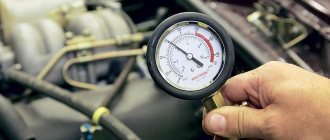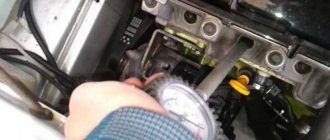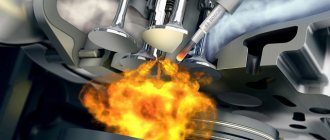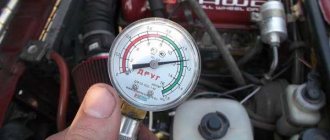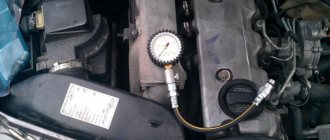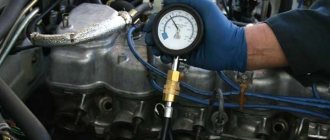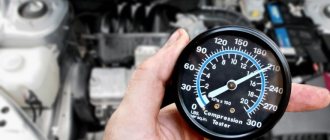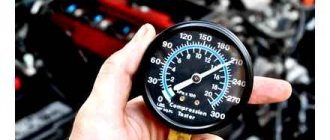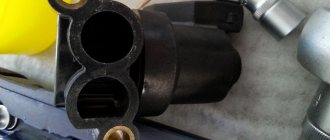The compression pressure in all cylinders should not differ by more than two units. Note that the compression amount should increase quickly on a healthy engine; Low compression pressure on the first revolution of the crankshaft accompanied by a gradual increase in pressure on subsequent revolutions of the crankshaft indicates wear on the piston rings. A low pressure value at the first revolution of the crankshaft, which increases slightly thereafter, indicates a loose valve fit, a broken cylinder head gasket or a crack in the cylinder head. Worn valve stem ends can also cause low compression pressure.
Opel does not determine the exact compression pressure, but if the compression pressure in the cylinders is less than 10, this indicates engine wear.
If the pressure in one cylinder is low, carry out the following test. Pour some engine oil through the spark plug hole into the cylinder and check the compression pressure.
If pouring oil into the cylinder increases compression pressure, this indicates that the cylinder or piston rings are worn.
Low pressure in two adjacent cylinders indicates a burnt gasket between the cylinders.
If the pressure in one cylinder is 20% less than the others and the engine idles rough, this indicates a worn camshaft cam.
If the compression pressure is too high, this indicates that the combustion chamber is coated with a thick layer of carbon deposits.
After this check, screw in the spark plugs and connect the high-voltage wires to them.
Compression is the highest level of pressure in the engine cylinders during the combustion process of the combustible mixture. If there is no compression in one cylinder or several at once, then this problem needs to be corrected urgently. What are the signs and causes of low compression? You will learn more about this here.
Signs and causes of disappearance
There are actually quite a few signs and reasons why there is no compression in one, two or all cylinders at once. Therefore, for users of our resource, materials have been collected that can help determine a decrease in the pressure level in the system.
Signs
If a gasket burns out in the cylinder head, the tightness of the cylinder itself is immediately compromised. This can be seen if exhaust gases begin to escape through the resulting gap. At this moment, the rings become stuck, which entails increased consumption of motor fluid and gasoline. In addition, in some cases, the engine power may increase, and smoky exhaust will come out of the exhaust pipe.
Cylinder operation diagram
If your car has lost compression in all cylinders at the same time or in just one of them, then the signs may be as follows:
- the engine became much more difficult to start;
- the engine is unstable, both at idle and while driving in gear, at all speeds;
- you noticed that your “iron horse” began to consume much more fuel;
- problems also began with the cylinders;
- if your car is equipped with a diesel internal combustion engine, then while the engine is running you will hear frequent popping noises;
- The pressure in the cooling system pipes increases.
Causes
What could be the reasons? There are a lot of them, but we will look at them all:
- cracks have appeared in the exhaust valve device, as a rule, this is caused by wear of the motor;
- the exhaust valve fits very poorly, which entails leakage through the place where the valve comes into contact with the “seat”;
- the valve “seat” itself is completely destroyed or has mechanical damage;
- The cylinder head gasket has burnt out. This could happen due to wear and tear. In addition, the cause of gasket wear may be contamination on the contact surfaces of the gasket. It can also burn out as a result of engine overheating, which will subsequently lead to cracks on the block or deformation of the cylinder head or the block itself;
- due to engine overheating, cylinder scuffing may occur;
- the cylinder-piston group in your engine is worn out;
- the inter-ring bridges of the piston have failed, that is, they have collapsed;
- in addition, the reason why there is no compression in one or two cylinders may be a failure of the intake valve;
- a crack has formed in one or more cylinders or on the pistons themselves;
- carbon deposits have appeared on the oil seals and piston rings, which reduces the pressure in the system;
- there are malfunctions or malfunctions in the operation of the gas distribution system;
- broken chain or timing belt. If the timing belt or chain breaks while driving a car, this may well be the reason why the valves are bent;
- the valve has stopped closing or there is a large gap when closing it. If the gap is too large, then the valve most likely does not open enough, which may be caused by incorrect adjustment or wear of the elements. Additionally, if there is not enough air flowing to one or more of the cylinders, you will hear a knocking sound under the valve covers.
Oil check
Diagnostics can be performed using motor fluid. But for this you will still need a compression gauge:
- Open the hood and disconnect the high voltage wires from the spark plugs.
- Unscrew them from their seats. Pour 30-50 grams of motor oil into the sockets where they are installed.
- Carry out a pressure diagnostic with the device. If the operating parameter has increased, and there is no difference in performance between the cylinders, then repair the seals or rings. They could have coked up. You can replace them yourself. In the case of rings, you will have to remove and disassemble the block head.
How to check compression?
Using a compression gauge
To understand whether your engine has compression or not, you need to use a compression gauge. The measured level must match that indicated in the service manual for your car. The measurement procedure itself must be carried out on a motor with a working electric starter drive system and a powerful battery. Otherwise, achieving an accurate result will be very difficult.
So, you will need a compression gauge. It is, in fact, a regular pressure gauge, only with extensions and adapters for spark plugs of various sizes installed on it. Please note that the compression gauges for diesel and gasoline cars are different, since the pressure level in a diesel engine is much higher than in a gasoline engine. Today, the cost of one compressor can vary from 25 to 50 dollars. This is about 250 - 1,300 hryvnia (800 - 5,000 rubles).
Checking with a compression gauge
- First of all, open the hood, unscrew and remove all the spark plugs from the connectors.
- Then you should prepare the compression gauge itself. To do this, decide which adapter and extension cord you need, after which you need to connect it all.
- Then the adapter from the device must be carefully screwed into the spark plug connector, insert the key into the ignition switch and turn the starter. If you have a vehicle with a diesel engine, you will also need to unscrew the injectors.
- Check the pressure level in each cylinder.
- Check the compression gauge readings with those specified by the manufacturer of your car. Thus, you can draw a conclusion about the condition of the piston group of your engine.
Oil check
You can also check whether there is compression in one or two cylinders or not using regular engine oil. Pour about thirty to fifty grams of liquid into the socket of the unscrewed spark plug, and then check the level again using the device. If you see that the compression level has increased sharply, and the difference in levels between the cylinders has disappeared, then this may indicate one thing. The rings or their seals are coked in your engine.
In this case, consider yourself lucky. Because you can replace oil seals at home. If the problem is in the rings, then the situation here is a little more complicated, since the cylinder head will have to be dismantled. However, this procedure is not particularly complicated and, accordingly, not particularly expensive.
Methods for checking compression, causes of low compression. Motor repair or replacement?
Compression is the amount of maximum pressure in the cylinder created when the engine is idling with the starter (for example, when the spark plug is turned off). Engine compression should not be confused with the compression ratio, because these are different concepts.
Compression is a force exerted on a gaseous body, leading to a decrease in the volume it occupies, as well as an increase in pressure and temperature. In the broadest sense of the word, compression is the amount of pressure that is created in the cylinder at the end of the compression stroke.
When diagnosing malfunctions associated with interruptions in engine operation, the first step is to measure the compression. This will give you the right direction for further troubleshooting. You can improve the ignition and fuel supply as much as you like, but if the cylinder is not sealed enough, then it will not work normally. Timely compression measurements can detect cylinder depressurization in the early stages, thus saving money on repairs and time in troubleshooting.
Diesel engines are especially demanding on compression, since in them the fuel ignites without the use of a spark plug. In such an engine, a portion of fuel is injected through a nozzle into air heated from compression in the cylinder (to a temperature exceeding the ignition temperature of the fuel). As a result, if there is no decent compression, then there will be no conditions for ignition of diesel fuel.
During the injection of the fuel mixture, it is atomized, and then combustion centers appear around individual droplets of the fuel mixture; as the fuel mixture is injected, it burns in the form of a torch.
Since diesel engines are not subject to the phenomenon of detonation characteristic of engines with forced ignition, they can use higher compression ratios (up to 26), which, in combination with long combustion, ensuring constant operating pressure, has a beneficial effect on the efficiency of this type of engine , which can exceed 50%.
How to measure compression correctly
To measure compression, you need to install a compression gauge instead of a spark plug (ignition or glow plug). This device is a pressure gauge connected by a hose to a fitting and a check valve. As the engine crankshaft rotates, air is forced into the hose until the pressure in the hose equals the maximum pressure in the cylinder. Its value will be recorded by a pressure gauge.
When measuring compression, important rules must be followed. Firstly, the engine must be “warm”. The fuel supply must be turned off. You can, for example, turn off the fuel pump, injectors, or use other methods to prevent large amounts of fuel from entering the cylinders. Secondly, you need to turn out all the candles. Selective removal of spark plugs, practiced at some service stations, is unacceptable, as it increases the rotational resistance and arbitrarily reduces the speed when the engine is cranked with the starter. Thirdly, the battery must be fully charged and the starter must be in working order.
Compression is measured with both the throttle valve open and closed. Moreover, each method gives its own results and allows you to identify its own defects. So, when the valve is closed, little air will obviously enter the cylinders, so the compression will be low and will be about 0.6-0.8 MPa. Air leaks in this case are comparable to its entry into the cylinder. As a result, compression becomes especially sensitive to leaks - even with small leaks, its value drops several times.
When measuring compression with the throttle open, the picture will be different. A large amount of incoming air and an increase in pressure in the cylinder, of course, contribute to an increase in leaks. However, they are obviously less than the air supply. As a result, the compression does not drop so significantly (to approximately 0.8-0.9). Therefore, measuring compression with an open valve is better suited for determining more “severe” engine defects, such as piston failures, ring coking, valve burnouts, and cylinder surface scuffing.
In both measurement methods, it is advisable to take into account the dynamics of pressure growth - this will help to establish the true nature of the malfunction with greater probability. So, if on the first stroke the pressure measured by a compression meter is low (0.3-0.4), and during subsequent strokes it increases sharply, this indirectly indicates wear of the piston rings. In this case, pouring a small amount of oil into the cylinder will immediately increase not only the pressure on the first stroke, but also the compression.
Increase compression level
At home, this is only possible if the cause of its appearance is carbon deposits on the pistons and cylinders.
- You will need denatured alcohol and kerosene. Mix 25 grams of each in a 1:1 ratio. This amount is needed for one cylinder. Accordingly, four cylinders will require four times more mixture.
- Then warm up the engine to operating temperature.
- Approximately 50 grams of the resulting mixture are placed into each cylinder through the spark plug hole. So the car needs to be left for 10 hours. After 10 hours, pour a little oil into each cylinder and start the engine, it should run for 20-30 minutes. The carbon deposits from the exhaust gases should burn out.
How to properly control pressure in engine compartments
To determine compression, a device is used, which is a pressure gauge with special adapters. Using adapters, this device is connected to the spark plug sockets of gasoline engines or the injector holes of diesel engines. In this case, it is necessary to follow some rules, observing a clear sequence of actions:
- It is important to make sure that the battery is charged and the starter is in good condition;
- Unscrew the candles and thoroughly clean their nests of debris;
- Then carefully connect all parts of the device to the engine through the spark plug holes or diesel injector holes.
- Start the engine, while recording the instrument readings. You should start the engine with the throttle valve open and also closed, comparing the results in the future. Check each cylinder in this way;
- Compare the results obtained with the necessary technical data for a specific vehicle. Based on these data, one can quite accurately draw conclusions about the condition of the timing belt, as well as the piston engine group.
Video “Measuring compression in the engine”
We invite you to learn how to measure blood pressure yourself.
What is the first thing they do when diagnosing an engine? That's right, they measure the compression in the cylinders. Many believe that its value determines the health of the engine. The authors find out whether this is so during the next analytical examination.
Compression is a vulgarism. That's right - the pressure at the end of the compression stroke. This is the pressure that is created in the cylinder when the ignition is turned off (or without fuel supply - for a diesel engine) with the piston position at top dead center. So, many diagnosticians, based on the measured compression (sorry, science, for the jargon!) give a conclusion: “the patient is alive” or “to the morgue,” that is, for major repairs.
According to many advanced motorists, compression is almost everything for an engine! But is it?
Using a compression gauge
To perform the test, you will need an appropriate device. A compression gauge is a simple pressure gauge equipped with extensions, as well as adapters designed to connect to different spark plugs. The types of such devices differ depending on the type of power unit - gasoline or diesel . This is due to the fact that the latter has a higher compression level.
- Open the hood of the car, disconnect the wires from the spark plugs and unscrew them with a wrench. Remove devices.
- Prepare the device for diagnostics. Connect an extension cord and adapters of appropriate sizes to it, install them in the spark plug sockets.
- After installation, sit in the driver's seat and turn the starter device. On a diesel car, when diagnosing compression, it is necessary to remove the injectors.
- Perform a check on each engine cylinder. The obtained indicators must be compared with those indicated by the vehicle manufacturer. They are usually noted in the service manual.
Compression and compression ratio are the same thing: the first fairy tale
No not like this! Compression is the pressure in the cylinder, the compression ratio is a dimensionless parameter that describes the geometric parameters of the cylinder: it is the ratio of the total volume of the cylinder to the volume of the compression chamber (the compression chamber is the volume of space above the piston at its position at TDC (it is also called the volume of the end of compression - this is the same thing). Calling it a combustion chamber is incorrect, since fuel combustion occurs throughout the entire volume of the cylinder.) Compression depends on the compression ratio, but the compression ratio does not depend on compression! Compression also depends on a bunch of parameters: compression start pressure, valve timing adjustment, temperature at which the measurement is carried out, leaks from the combustion chamber. And leaks are determined by wear of the rings and cylinders.
“Compression” is the maximum pressure that we measure in the cylinder when the ignition is turned off.
How long will the engine last?
Low pressure is a problem that car enthusiasts often face. If the drop is insignificant, then the engine can be operated for a long time. But keep in mind that too little compression or its complete absence may be due to the strong heating of the unit.
Long-term operation of a car with an overheated internal combustion engine will eventually lead to its complete failure.
Detailed instructions for measuring pressure in engine cylinders are given below and filmed by the Made in Garage channel.
Increased compression - increased power: the second fairy tale
Not certainly in that way. Compression can be increased in two ways - increasing the compression ratio or reducing leaks from the combustion chamber. Let's see what happens in each case: we have a stand at our disposal.
First, let's reduce the volume of the compression chamber. The easiest way to do this is to grind the bottom plane of the cylinder head. The base engine of the “eleventh” VAZ has a cylinder displacement of slightly more than 370 cubic meters. With a standard compression ratio of 9.8, the volume of the compression chamber will be 42.6 cm³. You can calculate that by removing 2 mm from the seating surface of the cylinder head, we reduce the volume of the compression chamber by 5.1 cm³. The new compression ratio will be 11 units, that is, 1.2 higher than that of the base engine. Now, just out of interest, let's remove another 2 mm. The compression ratio increases to 12.6. In the textbook we find the required formula and get: the thermal efficiency of the piston engine cycle should theoretically increase in the first case by at least 4%, in the second - by 9%. Great!
Now we put these heads on the bench motor and take the torque characteristics. The reduction in fuel consumption is significantly less than the theory promised - by 2.5% in the first case and by 4.5% in the second. Moreover, the effect is more pronounced in the zone of low loads. The increase in power is even less: 2–3% at most, and in the low and medium speed zone. And at high levels there is no effect.
Everything is clear: with an increase in the compression ratio, the pressure in the cylinder increases sharply, this increase provokes detonation, the corresponding sensor catches it and shifts the ignition timing back. Consequently, the power drops. And therefore the theoretical effect is significantly reduced. But the exhaust temperatures increase, which means that the risk of burning valves and pistons with such an engine is much higher.
Where does the compression go?
Air under pressure can break through in several directions at once - through the pistons with piston rings, or through the cylinder head - through the intake or exhaust valves.
Non-mechanical damage
After repairing an engine by incompetent craftsmen, it happens that the valve timing is set incorrectly, and the valves seem to close, but not when they should - during the compression stroke the valves remain slightly open - this may be enough for air to escape, but the displacement is not enough, so that the valves come into contact with the piston and bend.
Another example is coking and ring sticking. In this case, the compression valves lie in the grooves and gases easily pass through them, because there is no seal. In this case, usually the oil scraper rings work, so the oil does not seal the resulting cracks. This is a similar example to when oil is washed off the cylinder walls by unburned fuel, but here the oil is simply removed by oil scraper rings.
Mechanical damage, wear
In case of mechanical damage, valves are more likely to suffer - they can burn, bend, fall out, the valve seat can burn out - in general, there will be no necessary mating of parts, and, accordingly, gases will break through.
The valve can bend for various reasons - the same belt will break, and the valves will meet the piston in an unequal battle. The result of this battle is obvious, so change the belt on time.
No compression - straight to capital: the third tale
Typically, a mechanic who discovers low compression immediately declares: “The engine is worn out and needs some capital.” Is everything so clear?
Of course not! For argument's sake, we can name twenty possible reasons for decreased compression. There are problems with the gas distribution mechanism, mechanical or thermal damage to engine parts, and coking of the piston rings. And only one of them will be associated with catastrophic wear of the engine. It is important to be able to distinguish between these causes, understand the degree of their danger and know methods to combat them. But this is a topic for a separate article.
Let's sum it up
Taking into account the above, it becomes clear that if the compression in the cylinders has dropped not due to a burnt-out valve or problems with the gasket, then more serious engine repairs cannot be avoided.
Finally, we note that in order to avoid problems with compression on relatively “fresh” engines, it is necessary to pay attention to the quality of fuel and oil, driving style and operating conditions of the vehicle, as well as monitor the condition and performance of the power system. In other words, it is necessary to avoid active carbon formation in the cylinders, since coke and deposits often cause sticking of rings and coking of valves.
Compression in a car engine: what it affects and how to check. How to check compression without a compression meter, take readings using a device.
Determination of the condition and degree of wear of the engine. What signs indicate severe wear of the internal combustion engine. Methods of checking and diagnosing the condition of the motor.
Features and procedure for independently measuring the exact compression of a diesel and gasoline engine. Compression “cold” and “hot”, malfunctions.
High compression in the engine and the main reasons for increased compression. Why does compression also decrease across the cylinders? Tips and tricks.
Diesel engine compression indicator. The main reasons and main signs of decreased compression. Starting the engine with insufficient pressure in the cylinders.
Problems starting a diesel engine. Signs of low compression and causes of malfunction: timing belt, cylinder mirror, piston and rings. We measure the compression.
Source
The higher the compression, the better: the fourth tale
Often, from apologists for various additives, you hear how the compression jumped after the next treatment of the engine. Growth up to 15 bar, up to 17 bar! But we must keep in mind that in normal condition, even after restoring the gaps to the state of a new engine, you will not get compression higher than standard.
Where do the numbers come from? Usually, on a disassembled engine, it is clear that after processing the combustion chamber is overgrown with something unknown and, as a result, the volume of the compression chamber has decreased. But these deposits interfere with heat removal from the combustion chamber. Hence detonation, glow ignition, etc. So we shouldn’t rejoice at the unprecedented increase in compression, but vice versa.
Change in specific fuel consumption at fixed speeds (2500 rpm) in two engine variants - basic and with rings in which the gaps are increased. Compression has dropped, but in terms of consumption this is noticeable only at low loads.
What are the reasons for poor gear shifting?
Difficulty shifting gears can occur as a result of improper operation of the gearbox, or due to operation of the vehicle on bad roads. Problems with the gearbox sooner or later occur in used cars.
If you have difficulties when trying to switch to another gear, you cannot shift or it takes a lot of effort, then there is clearly a malfunction. Most often, car owners turn to a car service when they have difficulty engaging first or reverse gear. A fairly common problem on VAZ and Ford Focus cars.
Let's look at the faults that lead to difficult gear shifting:
- Clutch malfunction. In this situation, the gears will engage either poorly or not completely. A common occurrence in VAZ cars that have fur cables. the clutch is moving away from the mount.
- Problems in the drive of the switching mechanism. Broken traction leads to difficult engagement of 1st and reverse gears.
- The jet thrust is faulty.
- Wear of plastic parts in the box control drive.
- The slide is incorrectly positioned. A weighty element, incorrect adjustment leads to malfunctions.
- Bearing wear. This is a fairly rare occurrence; anyone can experience this, especially when you have a manual transmission. In such a situation, it is usually difficult to engage first gear.
- The box shaft is faulty. By itself, it is not subject to heavy loads, which could lead to wear. A factory defect may cause the entire unit to be replaced.
- Clutch failure. Often found among owners of cars with an automatic transmission. The malfunction is eliminated by replacing the clutches.
- Faulty synchronizers are the most common problem among gearbox breakdowns. They are made of brass, and this metal itself is quite soft. During use, it wears out and wears out. The breakdown is usually accompanied by a grinding noise when switching to another speed.
Some faults can be diagnosed and fixed independently, but failure of the bearings or shaft cannot be determined. For these purposes, you need special tools and equipment, as well as experience. In this situation, if you have problems shifting gears, it is best to go to a service station.
And it’s not a fairy tale at all.
So what does compression do? For a lot! The main thing is the starting properties of the motor, especially at low temperatures.
This primarily applies to diesel engines, where the pressure and temperature at the end of compression determine whether the fuel in the cylinder will ignite or not. But gasoline engines in a cold state are also sensitive to changes in compression: it affects the volatility of the fuel, which, during a cold start, should only theoretically evaporate on the way to the cylinder. But in reality, it gets there in the form of non-flammable liquid drops.
Reduced compression increases crankcase gas pressure. In this case, a larger volume of oil vapor flies through the ventilation system to the engine inlet. This is bad: toxicity increases, and the rate of combustion chamber contamination increases sharply.
Uneven compression across the cylinders causes engine vibrations, especially noticeable at idle and at low speeds. And this, in turn, harms both the transmission and the engine suspension. And to the driver himself.
In short, the role of compression as a diagnostic sign, largely characterizing the condition of the engine, is very great. And our “fairy tales” in no way call for giving up on her - on the contrary! But the desire for an unbridled increase in it in search of additional “horses” is generally futile.
Debugg
Eliminating the causes of a drop in compression in one of the cylinders directly depends on what was to blame for its occurrence.
Most often, this problem occurs due to the occurrence of rings. The formation of carbon deposits (coking) in one of the cylinders occurs due to the penetration of a large amount of oil into it.
For example, this can happen if the valve stem seals for that cylinder are damaged.
The difficulty of repairing compression loss caused by rings depends on the nature of the damage.
If they just lay there, then you can try to decarbonize them. But if the rings burst, then you will have to disassemble almost the entire engine to replace the damaged elements.
The same applies to valves. If they are misadjusted, it is enough to bring the thermal gaps back to normal. But if the valves and their seats are burnt, then repair work is carried out on the cylinder head - the valves are changed and they are ground in.
Regarding the cylinder head gasket, if it’s all because of it, then they change it. But with the block head, not everything is so simple.
If it was caused by overheating, then you can still fix the problem by trimming the surface.
But if defects form in the body of the head, it is replaced. Any piston malfunction is definitely a replacement.
POPULAR WITH READERS: What oils should be poured into the engine
Non-mechanical damage
Such problems include mistakes made during a poorly carried out “overhaul” (overhaul of the motor). It is possible that the valve timing was adjusted incorrectly and the valve elements are not closing at the right time. During the compression stroke, due to clamped valves, the piston group does not work correctly, as a result of which compression is lost. As a result, some of the air leaves the system.
The cause of the malfunction may be due to coking and sticking of the piston rings. Such a malfunction leads to the fact that the valves, which are clamped while the engine is running, can allow gases to pass through the sealing elements. The valve stem seals work without failure, but the lubricating fluid cannot properly fill all the cracks formed in the system. As a result, the consumable material is lubricated from the walls of the motor with the remains of the combustible mixture.
Self-diagnosis
By the operation of the engine, you can independently judge its wear and loss of pressure in the cylinders. Here are some symptoms that should alert the driver to possible problems with the internal combustion engine:
- Starting is significantly difficult , especially for diesel units (which are started “cold” in winter);
- Operation of the engine at idle speed becomes impossible due to their instability;
- In a diesel internal combustion engine, especially when starting “cold”, there is bluish smoke in the exhaust, which is due to the presence of unburned diesel fuel vapors;
- Increased operating noise . This primarily applies to diesel engines;
- Increased fuel consumption ; when driving, a larger supply is required;
- If it is necessary to remove additional power from the engine (driving on a steep climb), a characteristic sound is heard in the valve pressure unit;
- When the power unit, especially a diesel one, is operating, skips are observed, accompanied by popping noises .
- Damage to the cylinder head gasket with characteristic burnout and exhaust sounds during operation.
Table: measurement results
| Cause of the problem | Symptoms of a problem | Compression level, MPa | |
| The damper is fully open | The damper is closed | ||
| The power unit is working properly | — | 1,0-1,2 | 0,6-0,8 |
| Crack or other defect in the piston bridge | the appearance of blue smoke from the muffler, increased pressure in the crankcase | 0,6-0,8 | 0,3-0,4 |
| Piston burnout |
| 0,5-0,5 | 0-0,1 |
| Rings sticking in piston grooves |
| 0,2-0,4 | 0-0,2 |
| Piston element and cylinder scuffing |
| 0,2-0,8 | 0,1-0,5 |
| Valve deformation | One or more engine cylinders cannot operate at low speeds | 0,3-0,7 | 0-0,2 |
| Valve burnout | One or more engine cylinders cannot operate at low speeds | 0,1-0,4 | |
| Valve sticking | One or more engine cylinders cannot operate at low speeds | 0,4-0,8 | 0,2-0,4 |
| The appearance of a defect on the camshaft cam profile (for engines equipped with hydraulic tappets) | One or more engine cylinders cannot operate at low speeds | 0,7-0,8 | 0,1-0,3 |
| An increase in the volume of deposits and soot in the combustion chamber along with wear of the rings and valve stem seals | Increased consumption of engine fluid, blue smoke coming from the exhaust pipe | 1,2-1,5 | 0,9-1,2 |
| Natural wear of piston group elements | Increased consumption of engine fluid, blue smoke coming from the exhaust pipe | 0,6-0,9 | 0,4-0,6 |
More about Aveo: General Motors vacuum sensor 96325870 AVEO 1.2 MATIZ absolute pressure MAP 96325870 General Motors. Wholesale and retail.
